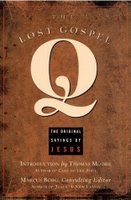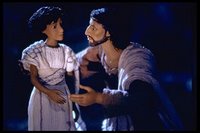The Essential Jesus
This isn't so much of a formal review as a few thoughts on Crossan's Book which I read over the autumn (fall) last year.
================
 Unlike John Dominic Crossan's previous works "The Essential Jesus" is more of a popular level text, which claims to be "the definitive presentation of Jesus' authentic sayings and teachings". Essentially it's a compilation of what Crossan considers to be the earliest, and authentic, sayings of Jesus alongside some of the earliest examples of Christian art. There's a brief introduction, ("Contexts") before the main section which lays out each saying on a fresh page and intersperses it with images of this early art (largely sculptures on sepulchres). The final two sections contain notes on the images, and then an inventory of images.
Unlike John Dominic Crossan's previous works "The Essential Jesus" is more of a popular level text, which claims to be "the definitive presentation of Jesus' authentic sayings and teachings". Essentially it's a compilation of what Crossan considers to be the earliest, and authentic, sayings of Jesus alongside some of the earliest examples of Christian art. There's a brief introduction, ("Contexts") before the main section which lays out each saying on a fresh page and intersperses it with images of this early art (largely sculptures on sepulchres). The final two sections contain notes on the images, and then an inventory of images.
Crossan's methodology is very controversial, and he his fair share of ardent admirers and vitriolic critics alike. In terms of the collection of sayings, the raw information displayed here is already present in "The Historical Jesus: A Revolutionary Biography", but by making this collection the core feature of this book, it brings Crossan's reformed gospel into clearer focus. The use of images also contributes to the clarity of image that Crossan lays before his readers.
One the points that I found most interesting is Crossan's theory that two characteristics typified Jesus's Kingdom program - eating and healing. To support this theory he not only relies on the historical texts but also the sheer number of the earliest Christian images which depict meals or healings. Out of 60 typical images, 27 are eating scenes, and 19 are healing scenes. Whilst I'm not convinced that art is any less subject to bias, ideology and removal if deemed offensive, it's certainly an interesting point. Certainly the artistic evidence supports the textual evidence on this point, and it's interesting that this aspect, and particularly it's political implications, tend to be underplayed today. I intend to follow this up at some stage with an examination of the frequency which these two features figure in Jesus biopics. Certainly the miracles are often underplayed. How will the meal scenes fair?
The other point which I found interesting was Crossan's skill in making familiar texts fresh once again. Crossan provides his own translation for each text, based on his own five point process. i - both individual and social, ii - both political and religious, iii - sayings require both interpretation and translation, iv - structural and spatial presentation to return to the original more memorable phrases, v - minimal and poetic, also to reflect the original easy-to-remember format. However, in places, the new translation seems less memorable than the standard canonical versions. Perhaps that simply reflects my own familiarity with these canonical version, but whilst overall Crossan achieves his objective, in places it seems to only make things less easy to remember.
What really breathes fresh life into these texts is the way he asks after certain sayings "but how is the Kingdom of God like that"? It's a incredibly simple question, but pretty soon I realised that in many places I had uncritically accepted the explanation I had been given years ago (at Sunday school probably), and had not really listened to those texts since. Whilst Crossan's "Mediterranean peasant" filter gives him a particular angle on these things, even those who reject the prominence Crossan gives it will find the question helps them look at things anew.
So overall it was an interesting and challenging read. I should be clear that I don't agree with all of Crossan's approach. In places it is overly pessimistic, in others it's more Mediterranean than Jewish. But even despite my misgivings he has a number of fascinating insights which make "The Essential Jesus" well worth a read.
================
 Unlike John Dominic Crossan's previous works "The Essential Jesus" is more of a popular level text, which claims to be "the definitive presentation of Jesus' authentic sayings and teachings". Essentially it's a compilation of what Crossan considers to be the earliest, and authentic, sayings of Jesus alongside some of the earliest examples of Christian art. There's a brief introduction, ("Contexts") before the main section which lays out each saying on a fresh page and intersperses it with images of this early art (largely sculptures on sepulchres). The final two sections contain notes on the images, and then an inventory of images.
Unlike John Dominic Crossan's previous works "The Essential Jesus" is more of a popular level text, which claims to be "the definitive presentation of Jesus' authentic sayings and teachings". Essentially it's a compilation of what Crossan considers to be the earliest, and authentic, sayings of Jesus alongside some of the earliest examples of Christian art. There's a brief introduction, ("Contexts") before the main section which lays out each saying on a fresh page and intersperses it with images of this early art (largely sculptures on sepulchres). The final two sections contain notes on the images, and then an inventory of images.Crossan's methodology is very controversial, and he his fair share of ardent admirers and vitriolic critics alike. In terms of the collection of sayings, the raw information displayed here is already present in "The Historical Jesus: A Revolutionary Biography", but by making this collection the core feature of this book, it brings Crossan's reformed gospel into clearer focus. The use of images also contributes to the clarity of image that Crossan lays before his readers.
One the points that I found most interesting is Crossan's theory that two characteristics typified Jesus's Kingdom program - eating and healing. To support this theory he not only relies on the historical texts but also the sheer number of the earliest Christian images which depict meals or healings. Out of 60 typical images, 27 are eating scenes, and 19 are healing scenes. Whilst I'm not convinced that art is any less subject to bias, ideology and removal if deemed offensive, it's certainly an interesting point. Certainly the artistic evidence supports the textual evidence on this point, and it's interesting that this aspect, and particularly it's political implications, tend to be underplayed today. I intend to follow this up at some stage with an examination of the frequency which these two features figure in Jesus biopics. Certainly the miracles are often underplayed. How will the meal scenes fair?
The other point which I found interesting was Crossan's skill in making familiar texts fresh once again. Crossan provides his own translation for each text, based on his own five point process. i - both individual and social, ii - both political and religious, iii - sayings require both interpretation and translation, iv - structural and spatial presentation to return to the original more memorable phrases, v - minimal and poetic, also to reflect the original easy-to-remember format. However, in places, the new translation seems less memorable than the standard canonical versions. Perhaps that simply reflects my own familiarity with these canonical version, but whilst overall Crossan achieves his objective, in places it seems to only make things less easy to remember.
What really breathes fresh life into these texts is the way he asks after certain sayings "but how is the Kingdom of God like that"? It's a incredibly simple question, but pretty soon I realised that in many places I had uncritically accepted the explanation I had been given years ago (at Sunday school probably), and had not really listened to those texts since. Whilst Crossan's "Mediterranean peasant" filter gives him a particular angle on these things, even those who reject the prominence Crossan gives it will find the question helps them look at things anew.
So overall it was an interesting and challenging read. I should be clear that I don't agree with all of Crossan's approach. In places it is overly pessimistic, in others it's more Mediterranean than Jewish. But even despite my misgivings he has a number of fascinating insights which make "The Essential Jesus" well worth a read.
Labels: Books, Historical Jesus, Jesus Seminar















